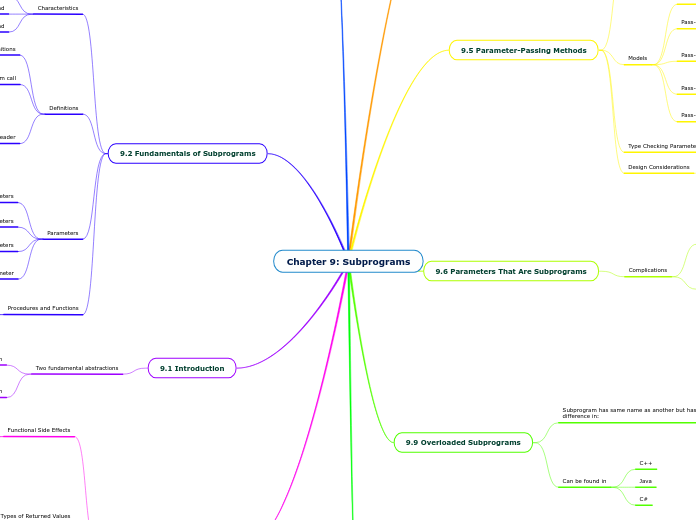Chapter 9: Subprograms
9.8 Design Issues for Functions
Number of Returned values
Multiple Returns
Tuples
F#
ML
1 Return
Most languages
Types of Returned Values
Subprograms as objects
Any type
Ruby
Python
Ada
No arrays/functions
C
Functional Side Effects
Pass-by-value/pass-by-reference
Functions can possibly cause side effects and aliasing
In-mode only
No side effects from parameters or aliasing of parameters/globals
9.1 Introduction
Two fundamental abstractions
Data abstraction
Process abstraction
Modern versions are written as subprograms
Not the same as methods.
First programmable computer used
via reusable cards
9.2 Fundamentals of Subprograms
Procedures and Functions
Functions
Mathematic equation
Procedures
Can change outside parameters
Parameters
Keyword Parameter
Formal Parameter attached
to Actual Parameter in Subprogram call
Positional Parameters
Actual parameters which take
the values of their corresponding
formal parameter in order
Actual Parameters
Parameters initialized within subprogram
Formal parameters
Ones in function call,
exist only while the
subprogram is called
Definitions
Subprogram Header
Specifies return value
Specifies subprogram variety
Names parameters
Chooses call name
Subprogram call
Considered active during call
Request subprogram execution
Subprogram Definitions
Describes interface
Characteristics
Returns to calling program at end
Calling program suspended until end
Single Entry Point
9.3 Design Issues for Subprograms
Which type of Subprogram
Closure
Nested Subprogram
Generic Subprograms
Subprogram which can be
used with any input type
Overloaded Subprograms
Same name for
multiple subprograms
9.10 Generic Subprograms
Generic in F#
Automatic generalization
If no type info included, assume generic
Generic in C#
actual type can be omitted if compiler can infer
No support for Wildcard type
Generic in Java 5.0
Collection
is a wildcard type
Uses
Generic in C++
Template function
Typename Identifier
Class Identifier
Polymorphic
Parametric polymorphism
Able to use different parameters per call instance
Subtype polymorphism
The type of an object can be derived from T
Can take parameters of different types on seperate calls
9.9 Overloaded Subprograms
Can be found in
C#
Java
C++
Subprogram has same name as another but has a least one difference in:
Return type
Types of parameters
Order of parameters
Number of parameters
9.6 Parameters That Are Subprograms
Complications
Which referencing environment should be used
Ad Hoc Binding
The environment of the call statement that passed the subprogram as an actual parameter
Deep Binding
The environment of the definition of the passed subprogram
Shallow Binding
The environment of the call statement that enacts the passed subprogram
Type checking the parameters of the activations of the subprograms that were passed as parameters
9.5 Parameter-Passing Methods
Design Considerations
Efficiency
Type Checking Parameters
Types of actual parameters checked for consistency w/ the types of corresponding formal parameters
Models
Pass-by-Name
The actual parameter is textually substituted for the corresponding formal parameter in all its occurrences in the subprogram
Pass-by-Reference
transmits an access path (an address) to the called subprogram
Pass-by-Value-Result
Combination between pass-by-value and pass-by-result
(For inout-mode parameters) Actual values are copied
Pass-by-Result
(For out-mode parameters) No value is transmitted to the subprogram
Pass-by-Value
Value of actual parameter is used to initialize the corresponding former parameter
Semantics
Inout mode
Receive and transmit data from and to the parameter
Out mode
Transmit data to actual parameter
In mode
Receive data from the corresponding actual parameter
9.4 Local Referencing Environments
Nested Subprograms
created to be able to create a hierarchy of both logic and scopes
Local Variables
Stack Dynamic
Bound to storage at start of execution(of subprogram) and unbound when execution terminates
Static
Require no run-time overhead for allocation and deallocation









